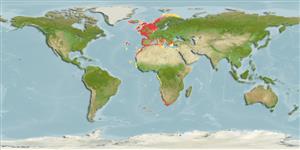Common names from other countries
Classification / Names / Names
Nomes comuns | Sinónimos | Catalog of Fishes (gen., sp.) | ITIS | CoL | WoRMS
Environment: milieu / climate zone / depth range / distribution range
Ecologia
; intervalo de profundidade 0 - 500 m (Ref. 1876). Temperate
Mediterranean and Atlantic Ocean: Atlantic coasts of Europe, Scandinavia (Ref. 1876).
Length at first maturity / Tamanho / Peso / Idade
Maturity: Lm ? range ? - ? cm Max length : 22.0 cm DL macho/indeterminado; (Ref. 1876)
Collected from the supralittoral and mediolittoral or intertidal zones up to a depth of 200 m (Ref. 2754).
Life cycle and mating behavior
Maturidade | Reprodução | Desova | Ovos | Fecundidade | Larvas
Members of the class Polyplacophora are mostly gonochoric. Life cycle: Eggs hatch into lecitotrophic planktonic trocophore larvae (no veliger stage) which later metamorphose and settle on the bottom as young adults.
Kaas, P. and R.A. van Belle. 1985. (Ref. 1876)
Categoria na Lista Vermelha da IUCN (Ref. 130435)
Categoria CITES (Ref. 108899)
Not Evaluated
Not Evaluated
Utilização humana
| FishSource |
Ferramentas
Mais informação
Nomes comunsSinónimosPredadoresReproduçãoMaturidadeDesovaFecundidadeOvosDesenvolvimento dos ovos
Idade/Tamanho
Crescimento
Comprimento-peso
Comprimento-comprimento
Morfologia
Larvas
Abundância
Fontes da internet
Estimates based on models
Preferred temperature
(Ref.
115969): 7 - 14.3, mean 9.6 (based on 477 cells).
Vulnerabilidade
Low vulnerability (12 of 100).
Categoria de preço
Unknown.
